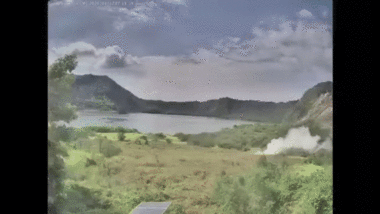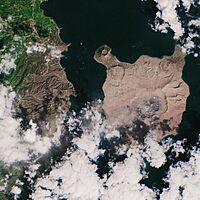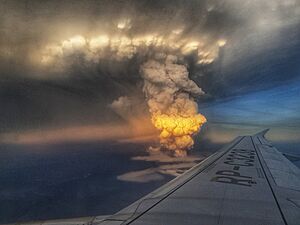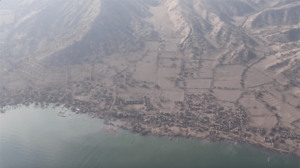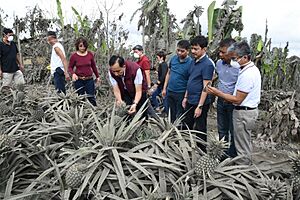2020–2022 Taal Volcano eruptions facts for kids
Quick facts for kids 2020–2022 Taal Volcano eruptions |
|
|---|---|
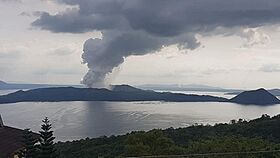
The January 12, 2020 eruption
|
|
| Volcano | Taal Volcano |
| Date | First eruption January 12–22, 2020 Second eruption Third eruption March 26-31, 2022 |
| Type | Phreatomagmatic, Phreatic, Plinian |
| Location | Batangas, Calabarzon, Philippines 14°00′38″N 120°59′52″E / 14.01056°N 120.99778°E |
| VEI | 4 (January 2020 eruption) |
| Impact | 39 dead (only 1 direct, 38 indirect) |
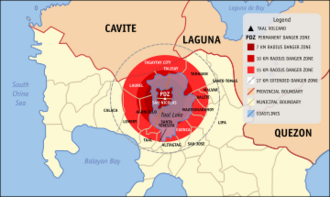
Map of Batangas highlighting the areas under the 14-kilometer radius danger zone
|
|
Taal Volcano in Batangas, Philippines is a very active volcano. From 2020 to 2022, it had several eruptions. The first big eruption started on January 12, 2020. It was a phreatomagmatic eruption, which means hot magma mixed with water, causing a huge explosion. This sent ash high into the sky over many parts of the Philippines, including Metro Manila.
Because of the ash, schools and workplaces closed, and flights were stopped. The eruption also caused the lake inside the volcano's main crater to dry up. The Philippine Institute of Volcanology and Seismology (PHIVOLCS) raised the alert level, warning that a dangerous eruption could happen soon. Smaller eruptions continued into 2021 and 2022, keeping everyone on alert.
Contents
Volcanic Activity: What Happened?
2020 Eruption Events
Taal Volcano erupted on the afternoon of January 12, 2020. This was 43 years after its last eruption in 1977. PHIVOLCS reported that small earthquakes started around 11 AM. Then, a steam-driven eruption, called a phreatic eruption, happened around 1 PM. This type of eruption happens when hot water or steam explodes.
Loud rumbling sounds were heard from the volcano island. PHIVOLCS quickly raised the alert level. Stronger explosions began around 3 PM, sending an ash column over a kilometer high. By 7:30 PM, the alert level was raised to 4. This meant a dangerous explosive eruption was possible. The volcano was spewing a huge column of steam and ash, 10 to 15 kilometers high. There was also a lot of volcanic lightning and wet ashfall.
Ash fell on many areas, including Cavite, Laguna, Metro Manila, and Pampanga. On January 13, the volcano started to shoot lava into the air, like a lava fountain.
The ash in the air made it hard to breathe in some cities. The air quality was unhealthy for people with breathing problems. By January 15, the lake inside the main crater had completely dried up. This was confirmed by satellites.
In August 2020, the volcano showed some activity again. It released steam and had small earthquakes. PHIVOLCS said this was normal but advised people to be ready.
2021 Eruption Events
In February 2021, people living on Taal Volcano Island were asked to leave. This was because the volcano was becoming more active. By March 9, PHIVOLCS raised the alert level to 2, meaning "increased unrest."
In late June, areas near the volcano experienced volcanic smog, also known as vog. This was caused by the volcano releasing a lot of sulfur dioxide gas. The vog even reached the Central Luzon region.
On July 1, the volcano erupted again for about five minutes. The alert level was raised to 3. Several smaller eruptions happened that day. On July 4, Taal Volcano released the most sulfur dioxide ever recorded from it.
More eruptions happened on July 7 and 8. These were short phreatomagmatic eruptions, sending grayish plumes of ash and steam into the air. By July 23, PHIVOLCS lowered the alert level back to 2.
In November 2021, more short phreatomagmatic eruptions were seen on webcams.
2022 Eruption Events
Between January 29 and 30, 2022, the volcano had nine small phreatomagmatic bursts.
On March 26, PHIVOLCS raised the alert level to 3 again. This was due to a short phreatomagmatic eruption. About 1,100 people living nearby had to evacuate. The eruption released toxic plumes of gas and ash. Locals reported an explosion and ash around the lake. High levels of toxic gas were recorded, along with many volcanic earthquakes and volcanic tremors.
By April 9, PHIVOLCS lowered the alert level back to 2.
Seismic Activity: The Earth Shakes
After the January 2020 eruption, many earthquakes shook the area around Taal Volcano. By February 13, 2020, over 2,400 earthquakes had been recorded. About 176 of these were strong enough to be felt by people. The strongest ones were around magnitude 4.1. These earthquakes caused shaking in nearby towns like Tagaytay and Malabon.
These constant earthquakes also caused cracks, called fissures, to appear in the ground. These cracks were seen in towns within the 14-kilometer danger zone around Taal. A crack even cut across a road connecting two towns.
On January 15, PHIVOLCS reported that the water in the Main Crater Lake had completely drained away. Parts of the Pansipit River also dried up. This happened because the ground was moving upwards due to magma pushing from below. This same movement caused all the earthquakes. Scientists also thought there might be cracks under Taal Lake where the water could have drained.
By January 27, fewer earthquakes were recorded, and they were weaker.
Impact: How the Eruption Affected People and Places
Casualties: Sad Outcomes
Sadly, some people lost their lives due to the eruption's effects. Most deaths were indirect, caused by health issues like heart attacks from stress in evacuation centers, or accidents during the emergency. One person died in a car crash during "zero visibility" because of ashfall.
Economic Impact: Money and Jobs
After the eruption, the demand for special N95 masks went up very quickly. Some stores tried to sell them for much higher prices. The government warned businesses not to raise prices unfairly. They even found some "fake" masks being sold.
The Philippine Stock Exchange stopped trading for a day after the eruption.
The eruption caused a lot of damage to farms. Crops like coffee, pineapples, rice, and corn were damaged. Fish farms in Taal Lake also suffered huge losses. The government planned to give money and supplies to farmers and fishermen to help them recover.
Some people in Biñan, Laguna, found a creative way to help. They used the ash from the volcano to make hollow blocks and bricks. These bricks were used to rebuild houses damaged by the eruption.
Phone companies offered free calls and internet. Water companies sent water tankers to evacuation centers. The main power company set up solar-powered charging stations. The postal service stopped mail delivery in the danger zone.
Health Concerns: Staying Safe
The Department of Health told people to stay indoors and avoid outdoor activities. They also advised against eating freshwater fish from Taal Lake, like tilapia, because they might have been affected by sulfur from the eruption.
However, the Agriculture Secretary said that fruits and vegetables covered in ash were safe to eat after being washed well.
Air Traffic: Flights Grounded
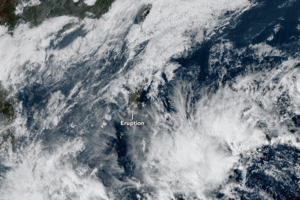
On January 12, 2020, the main airport in Manila, Ninoy Aquino International Airport (NAIA), stopped all flights. This was because volcanic ash is very dangerous for airplanes. Over 500 flights were canceled, affecting about 80,000 passengers.
The next day, flights slowly started again, but many were still canceled or delayed. Some international flights had to land at other airports in the Philippines or even in other countries like Japan or Hong Kong.
Clark International Airport also suspended flights for a while. Mactan–Cebu International Airport had to handle many diverted flights. They provided free bus services and discounts for passengers stuck there.
Sports: Games Postponed
College sports leagues like the UAAP and NCAA postponed games in Metro Manila on January 13, 2020. This was due to the ashfall. A football match for the AFC Champions League was also at risk but went ahead as planned.
See also
- List of large volcanic eruptions in the 21st century


